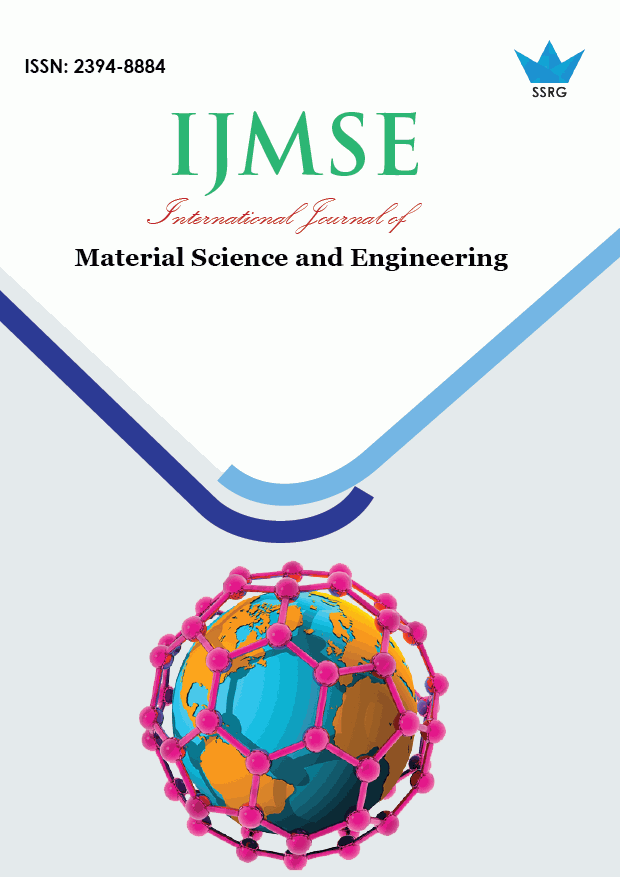Silicon Atom doped Mono layer InN; a DFT Study

| International Journal of Material Science and Engineering |
| © 2020 by SSRG - IJMSE Journal |
| Volume 6 Issue 1 |
| Year of Publication : 2020 |
| Authors : Jawed Ali, Irfan Ahmed, Abdul Sattar Larik, Mukhtiar Ahmed Mahar |
How to Cite?
Jawed Ali, Irfan Ahmed, Abdul Sattar Larik, Mukhtiar Ahmed Mahar, "Silicon Atom doped Mono layer InN; a DFT Study," SSRG International Journal of Material Science and Engineering, vol. 6, no. 1, pp. 1-4, 2020. Crossref, https://doi.org/10.14445/23948884/IJMSE-V6I1P101
Abstract:
The electronic and optical parameters of monolayer Indium Nitride (InN) are modified by Silicon (Si) atom substitution using first-principles DFT. Si atom doping (with varying concentration) causes the graphene like Dirac cone of InN to move up or down the Fermi Energy (EF) level or induces some energy gap at high symmetric K-point depending upon Si atom concentration. The overall absorption spectrum shows reduced strength; however the static reflectivity of InN is improved after Si atom substitution in its lattice
Keywords:
Grapheme, Electronic structures, InN co-doping, Absorption, Reflectivity.
References:
[1] Novoselov, K.S., et al., Electric field effect in atomically thin carbon films. science, 2004. 306(5696): p. 666-669.
[2] Pacile, D., et al., The two-dimensional phase of boron nitride: few-atomic-layer sheets and suspended membranes. Applied Physics Letters, 2008. 92(13): p. 133107.
[3] Vogt, P., et al., Silicene: compelling experimental evidence for graphenelike two-dimensional silicon. Physical review letters, 2012. 108(15): p. 155501.
[4] Vurgaftman, I., J.á. Meyer, and L.á. Ram-Mohan, Band parameters for III–V compound semiconductors and their alloys. Journal of applied physics, 2001. 89(11): p. 5815- 5875.
[5] Ponce, F.A. and D.P. Bour, Nitride-based semiconductors for blue and green light-emitting devices. Nature, 1997. 386: p. 351.
[6] Liao, J., et al., Design of High-Efficiency Visible-Light Photocatalysts for Water Splitting: MoS2/AlN(GaN) Heterostructures. The Journal of Physical Chemistry C, 2014. 118(31): p. 17594-17599.
[7] Chen, X.-P., et al., Density-functional calculation of methane adsorption on graphenes. IEEE Electron Device Lett, 2015. 36(12): p. 1366-1368.
[8] Şahin, H., et al., Monolayer honeycomb structures of group-IV elements and III-V binary compounds: First-principles calculations. Physical Review B, 2009. 80(15): p. 155453.
[9] Abbas, A.N., et al., Black phosphorus gas sensors. ACS nano, 2015. 9(5): p. 5618-5624.
[10] Zhou, M., et al., Adsorption of gas molecules on transition metal embedded graphene: a search for high-performance graphene-based catalysts and gas sensors. Nanotechnology, 2011. 22(38): p. 385502.
[11] Kresse, G. and D. Joubert, From ultrasoft pseudopotentials to the projector augmented-wave method. Physical Review B, 1999. 59(3): p. 1758.
[12] Kresse, G. and J. Furthmüller, Efficiency of ab-initio total energy calculations for metals and semiconductors using a plane-wave basis set. Computational Materials Science, 1996. 6(1): p. 15-50.
[13] Blöchl, P.E., Projector augmented-wave method. Physical Review B, 1994. 50(24): p. 17953.
[14] Perdew, J.P., K. Burke, and M. Ernzerhof, Generalized gradient approximation made simple. Physical review letters, 1996. 77(18): p. 3865.
[15] Marinopoulos, A., et al., Ab initio study of the optical absorption and wave-vector-dependent dielectric response of graphite. Physical Review B, 2004. 69(24): p. 245419.
[16] Muhammad, R., Y. Shuai, and H.-P. Tan, First-principles study on hydrogen adsorption on nitrogen doped graphene. Physica E: Low-dimensional Systems and Nanostructures, 2017. 88: p. 115-124.
[17] Rafique, M., et al., Structural, electronic, and magnetic behaviors of 5d transition metal atom substituted divacancy graphene: A first-principles study. Chinese Physics B, 2017. 26(5): p. 056301.
[18] Rafique, M., et al., Manipulation of inherent characteristics of graphene through N and Mg atom co-doping; a DFT study. Physics Letters A, 2018. 382(16): p. 1108-1119.
[19] Muhammad, R., Y. Shuai, and H.-P. Tan, A first-principles study on alkaline earth metal atom substituted monolayer boron nitride (BN). Journal of Materials Chemistry C, 2017. 5(32): p. 8112-8127.
[20] Sun, X., et al., Adsorption of gas molecules on graphenelike InN monolayer: A first-principle study. Applied Surface Science, 2017. 404: p. 291-299.
[21] Jalilian, J., et al., Tuning of the electronic and optical properties of single-layer indium nitride by strain and stress. Physica E: Low-dimensional Systems and Nanostructures, 2016. 83: p. 372-377.
[22] Gajdoš, M., et al., Linear optical properties in the projectoraugmented wave methodology. Physical Review B, 2006. 73(4): p. 045112.[23] Strite, S. and H. Morkoç, GaN, AlN, and InN: a review. Journal of Vacuum Science & Technology B: Microelectronics and Nanometer Structures Processing, Measurement, and Phenomena, 1992. 10(4): p. 1237-1266.
[24] Rani, P., G.S. Dubey, and V. Jindal, DFT study of optical properties of pure and doped graphene. Physica E: Lowdimensional Systems and Nanostructures, 2014. 62: p. 28- 35.
[25] Li, D., et al., Structural and electronic properties of MnO 3 (4) superhalogen clusters embedded in graphene. Chemical Physics Letters, 2014. 601: p. 16-20.
[26] Sun, M., et al., Tuning electronic and magnetic properties of blue phosphorene by doping Al, Si, As and Sb atom: A DFT calculation. Solid State Communications, 2016. 242: p. 36-40.
[27] Sun, M., et al., Magnetism in transition-metal-doped germanene: A first-principles study. Computational Materials Science, 2016. 118: p. 112-116.
[28] Wan, Q., et al., First-principles study of Ag-based p-type doping difficulty in ZnO. Optical Materials, 2008. 30(6): p. 817-821.

 10.14445/23948884/IJMSE-V6I1P101
10.14445/23948884/IJMSE-V6I1P101